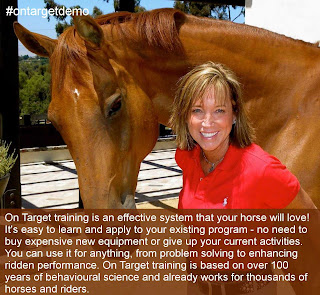The
concept of marginal gains is familiar to elite sportsmen and women,
the accumulative effect of multiple positive changes to training and
performance tactics that provides the winning edge. But can food
rewards also confer marginal gains?
Already
this summer, competitors across the country will have emerged from
the ring singing their horse's praises and offering them a Polo mint.
But how did their horses even know the tasty reward was for a
specific jump or particularly expressive trot? Can such a treat teach
anything other than pleasant associations with the arena's exit?
Food
rewards certainly did it for Beezie Madden last decade when she
applied former Sea World trainer, Shawna Karrasch's On Target
training to difficult horse, Judgement. When Beezie took on Michael
Matz' former ride he wouldn't jump a puddle, so bad was his attitude
to water jumps, but through the On Target system he fulfilled his
potential as a top Derby horse with a tribute film from Spruce
Meadows on his retirement to boot. So how did that work?
Marine
mammal trainers use 'bridge' signals such as clickers and whistles to
tell their dolphin students, right in the moment, that their effort
just earned a fish – a kind of IOU note if you like. This extra
piece of clear communication helps animals learn fast and well,
especially when tasks are broken into progressive increments that
give them a clue about what to do next.
Soon
after discovering horses back in the Nineties, Shawna Karrasch became
connected with John and Beezie Madden and set about developing her On
Target system, which uses food rewards and bridge signals, with their
horses. For the first time ever, even seasoned pros like the Maddens
had a consistent and reliable way to reward their horses during
training, increasing their enthusiasm for the job and adding another
marginal gain to their performances.
The
On Target story hasn't stopped there. Nearly 20 years on Shawna is
still working her magic, helping riders of all abilities get marginal
and quite substantially more than marginal gains, by giving them
extra clarity in their training, and better attitude from their
horses.
Seasoned
horsewoman, Helen Williams applied Shawna's On Target system to gift
horse, totally wild and super sharp Lusitano, Sofia, after early
efforts to tame her didn't quite have the expected results. Even with
many years experience and expertise gained from years in the saddle,
harking back to her teens growing up in India and riding with nothing
but cotton for reins at the Presidents Estate Polo Club, Helen could
only get as far as getting Sofia to eat from her hand. Clearly not
enough when Sofia escaped and ran amok with the Glamorgan Hunt,
jumping two five-bar-gates from a standstill. Amidst the ensuing
chaos MFH Jacky Thomas stated, “That’s a cracking little mare
with a hell of a jump – if you can catch her and break her, I’d
have her as a Master's horse next season!” Although Mr Thomas might
well have made his comments tongue in cheek, Helen did get to work on
the mare, and that's when the On Target system came in.
Under my guidance Helen quickly
found that using a clicker as a bridge signal gave her a way to tell
Sofia which behaviour had earned her the hand fed titbits, setting
her up for success. Helen could link the clicker to correct behaviour
more accurately than simply handing out the food, helping Sofia to
think more carefully about her actions. Now that Sofia knows which
behaviour will be rewarded she is willing to cooperate. And she is
happier and less reliant on treats as a result. This is because
unlike a bribe, the bridge signal comes during the event, not before,
and the food or other reward is given after. Therefore Sofia doesn't
need food to guide her behaviour.
Quite
a bit more than a marginal gain in this case! But if this is what the
On Target system could do for something as wild as Sofia and as
tricky as Judgement, just what could other horses and riders
achieve?
Find out more when Shawna Karrasch comes to Pencoed College for her only UK public
demonstration this year, at 7pm on Saturday 24th August 2013 where I will also be raising funds for Welsh cancer charity, Amser
Justin Time. Further training will also be available at the Williams'
farm near Cardiff. Visit www.jenninellist.co.uk
to find out more or look out for the fliers.






